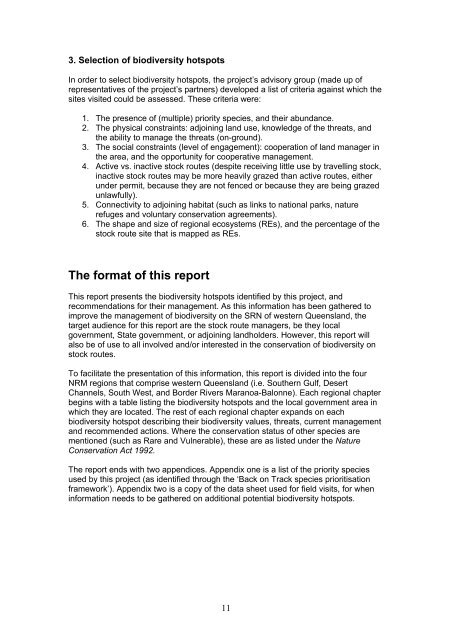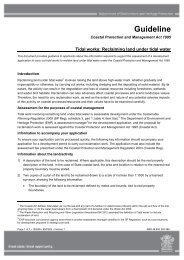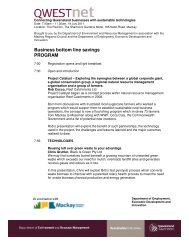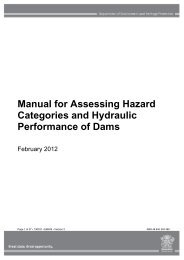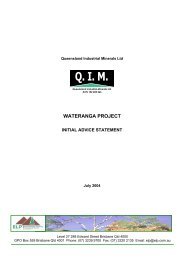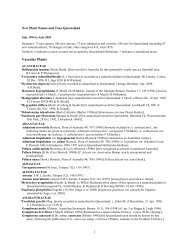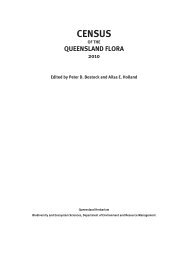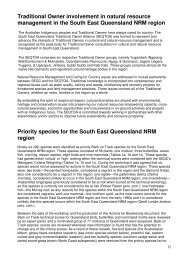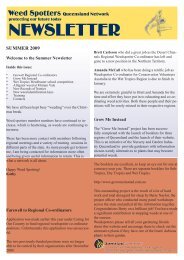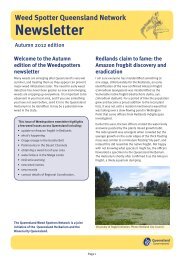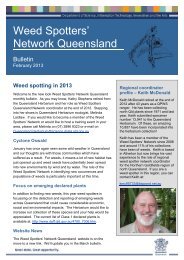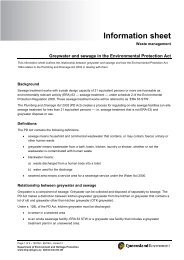Enhancing Biodiversity Hotspots Along Western Queensland Stock ...
Enhancing Biodiversity Hotspots Along Western Queensland Stock ...
Enhancing Biodiversity Hotspots Along Western Queensland Stock ...
You also want an ePaper? Increase the reach of your titles
YUMPU automatically turns print PDFs into web optimized ePapers that Google loves.
3. Selection of biodiversity hotspots<br />
In order to select biodiversity hotspots, the project’s advisory group (made up of<br />
representatives of the project’s partners) developed a list of criteria against which the<br />
sites visited could be assessed. These criteria were:<br />
1. The presence of (multiple) priority species, and their abundance.<br />
2. The physical constraints: adjoining land use, knowledge of the threats, and<br />
the ability to manage the threats (on-ground).<br />
3. The social constraints (level of engagement): cooperation of land manager in<br />
the area, and the opportunity for cooperative management.<br />
4. Active vs. inactive stock routes (despite receiving little use by travelling stock,<br />
inactive stock routes may be more heavily grazed than active routes, either<br />
under permit, because they are not fenced or because they are being grazed<br />
unlawfully).<br />
5. Connectivity to adjoining habitat (such as links to national parks, nature<br />
refuges and voluntary conservation agreements).<br />
6. The shape and size of regional ecosystems (REs), and the percentage of the<br />
stock route site that is mapped as REs.<br />
The format of this report<br />
This report presents the biodiversity hotspots identified by this project, and<br />
recommendations for their management. As this information has been gathered to<br />
improve the management of biodiversity on the SRN of western <strong>Queensland</strong>, the<br />
target audience for this report are the stock route managers, be they local<br />
government, State government, or adjoining landholders. However, this report will<br />
also be of use to all involved and/or interested in the conservation of biodiversity on<br />
stock routes.<br />
To facilitate the presentation of this information, this report is divided into the four<br />
NRM regions that comprise western <strong>Queensland</strong> (i.e. Southern Gulf, Desert<br />
Channels, South West, and Border Rivers Maranoa-Balonne). Each regional chapter<br />
begins with a table listing the biodiversity hotspots and the local government area in<br />
which they are located. The rest of each regional chapter expands on each<br />
biodiversity hotspot describing their biodiversity values, threats, current management<br />
and recommended actions. Where the conservation status of other species are<br />
mentioned (such as Rare and Vulnerable), these are as listed under the Nature<br />
Conservation Act 1992.<br />
The report ends with two appendices. Appendix one is a list of the priority species<br />
used by this project (as identified through the ‘Back on Track species prioritisation<br />
framework’). Appendix two is a copy of the data sheet used for field visits, for when<br />
information needs to be gathered on additional potential biodiversity hotspots.<br />
11


